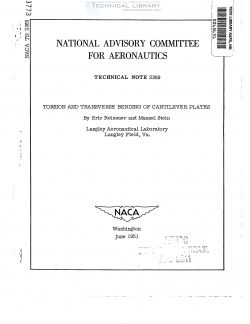naca-tn-2369
- Version
- 121 Downloads
- 1.07 MB File Size
- 1 File Count
- December 14, 2016 Create Date
- December 14, 2016 Last Updated
National Advisory Committee for Aeronautics, Technical Notes - Torsion and Transverse Bending of Cantilever Plates

The prdblem of combined bending and torsion of cantilever plates
of variable thickness, such as might be considered for solid thin high-
speed airplane or missile wings, is considered in this paper. The .
deflections of the plate are assumed to vary linearly across the chord;
minimization of the potential energy by means of the calculus of vari-
ations then leads to two ordinary linear differential equations for the
bending deflections and the twist of the plate. Because the cantilever
is analyzed as a plate rather than as a beam, the effect of constraint
against axial warping in torsion is inherently included. The applica-
tion of this method to specific problems involving static deflection,
vibration, and buckling of cantilever plates is presented. In the
static-deflection problems, taper and sweep are considered.
For analysis of thin solid wings of small aspect ratio such as
might be utilized in high-speed airplanes and missiles, beam theory is
no longer adequate. Wings of this type are more nearly plates than
beams and should be analyzed by plate theory. However, solutions to
the partial—differential equation of plate theory are not readily
obtained, especially for plates of arbitrary shape and loading. In the
present paper, therefore, a method is described for Obtaining ordinary
differential equations to replace the partial-differential equation.
The method employs the minimum—potential-energy principle in conjunction
with the assumption that the chordwise deflection'shape may be repre-
sented by terms of a power Series. The analysis of the present paper
is limited to the first two terms of this series. The first term
represents transverse displacement and the second represents twist.
Together they permit linear chordwise deflection (the assumption usually
made in wing design). Use of the first two terms in the series leads
to two ordinary differential equations that define the spanwise vari-
ation of the transverse displacement and rotation. If results of
greater accuracy are required, additional terms in the power series may
be included (that is, quadratic, cubic, etc.) with a corresponding
increase in the number of ordinary differential equations obtained.
Solution of the two ordinary differential equations, subject to
boundary conditions which arise naturally in the minimization procedure,
gives the bending deflection and twist at any cross section. The
stresses may be Obtained from the deflections by using the well—known
equations of plate theory. The order of accuracy of the stresses will
generally be less than that of the deflections. Because ordinary plate
theory is employed, the applicability of the analysis is limited to
plates in which the order of magnitude of the plan-form dimensions is
greater than ten times the order of magnitude of the thickness. To
extend the applicability of such an analysis to other dimensions, the
effects of transverse shear deformation must be included.
| File | Action |
|---|---|
| naca-tn-2369 Torsion and Transverse Bending of Cantilever Plates.pdf | Download |

Comment On This Post